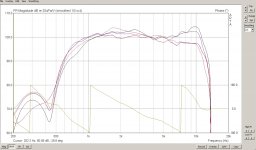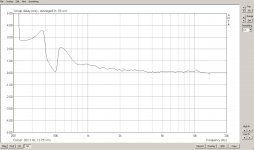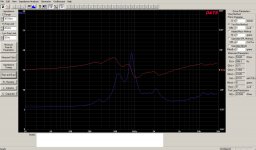Hi,
There's a gentleman in the UK who builds 10 and 15 cell multicell horns in his garage out of mdf..and sells them on e-bay. I took the plunge and purchased a pair of 15 cell. Modelled on a truncated version of the Vitavox these horns have a cut of around 300Hz.
And they sound excellent but there is so little information out there on multicells I took the plunge and took my own measurements.
I would really appreciate some informed comment and analysis of my results! Working with both the DATs programme and ARTA (of course!) I have created plots with FR and Phase, Group Delay and an Impedance and phase graph.
Briefly, the driver is the Beyma 750Ti, the FR plots are a single gated nest of curves taken at 0, 15, 30, 45 degrees horizontally at only 1metre. These were in room so not exactly definitive but a number of samples were taken. The crossover is set with DSP set at 680Hz/24dB/oct/LR with EQ at 6dB/octave rising from around 3KHz up to 12KHz. The mic was the DBX measuring mic which I have had good results from on a range of loudspeaker measuring tasks.
Here are the plot results as attachments...
There's a gentleman in the UK who builds 10 and 15 cell multicell horns in his garage out of mdf..and sells them on e-bay. I took the plunge and purchased a pair of 15 cell. Modelled on a truncated version of the Vitavox these horns have a cut of around 300Hz.
And they sound excellent but there is so little information out there on multicells I took the plunge and took my own measurements.
I would really appreciate some informed comment and analysis of my results! Working with both the DATs programme and ARTA (of course!) I have created plots with FR and Phase, Group Delay and an Impedance and phase graph.
Briefly, the driver is the Beyma 750Ti, the FR plots are a single gated nest of curves taken at 0, 15, 30, 45 degrees horizontally at only 1metre. These were in room so not exactly definitive but a number of samples were taken. The crossover is set with DSP set at 680Hz/24dB/oct/LR with EQ at 6dB/octave rising from around 3KHz up to 12KHz. The mic was the DBX measuring mic which I have had good results from on a range of loudspeaker measuring tasks.
Here are the plot results as attachments...
Attachments
It is probably a result of my measurement/gating. The pink noise (1/3oct smoothed) plots (not shown) show extension beyond and a gentler roll off. I was not really interested in the response at this end as the throat is a 2" (driver 3") and naturally rolls by then anyway. In terms of crossover points, and to reduce the impact of the comb filter effects due to the physical dimensions of the cell formation at HF I would probably go for 680Hz and around 6K3Hz with 24dB/oct LR filter slopes.
The Multicell should be crossed over to a dedicated HF device for optimum performance and the system preferably time aligned due to its depth as well but that's another issue! In my view, and probably because of the history of its original application, the multicell was often used over far too wide a bandwidth for best quality. As a section of a sphere it radiates far more omni directionally at the low frequency end near cut off and the cells interfere due to their dimensions at higher frequencies, but in my view, used sensibly can still provide superb results as long as you don't push them to the frequency extremes?
But really I didn't want to get too deep into discussions about the FR but I would like to hear from those that can read more deeply into the total performance of the device from the GD, Impedance and Phase plots...I have read the multicell, due to its structure of several small horns actually offers a good impedance load to the driver...do the plots reveal this to be the case? What other observations regarding their performance can be gleaned from the plots?
The Multicell should be crossed over to a dedicated HF device for optimum performance and the system preferably time aligned due to its depth as well but that's another issue! In my view, and probably because of the history of its original application, the multicell was often used over far too wide a bandwidth for best quality. As a section of a sphere it radiates far more omni directionally at the low frequency end near cut off and the cells interfere due to their dimensions at higher frequencies, but in my view, used sensibly can still provide superb results as long as you don't push them to the frequency extremes?
But really I didn't want to get too deep into discussions about the FR but I would like to hear from those that can read more deeply into the total performance of the device from the GD, Impedance and Phase plots...I have read the multicell, due to its structure of several small horns actually offers a good impedance load to the driver...do the plots reveal this to be the case? What other observations regarding their performance can be gleaned from the plots?
Last edited:
- Status
- This old topic is closed. If you want to reopen this topic, contact a moderator using the "Report Post" button.


